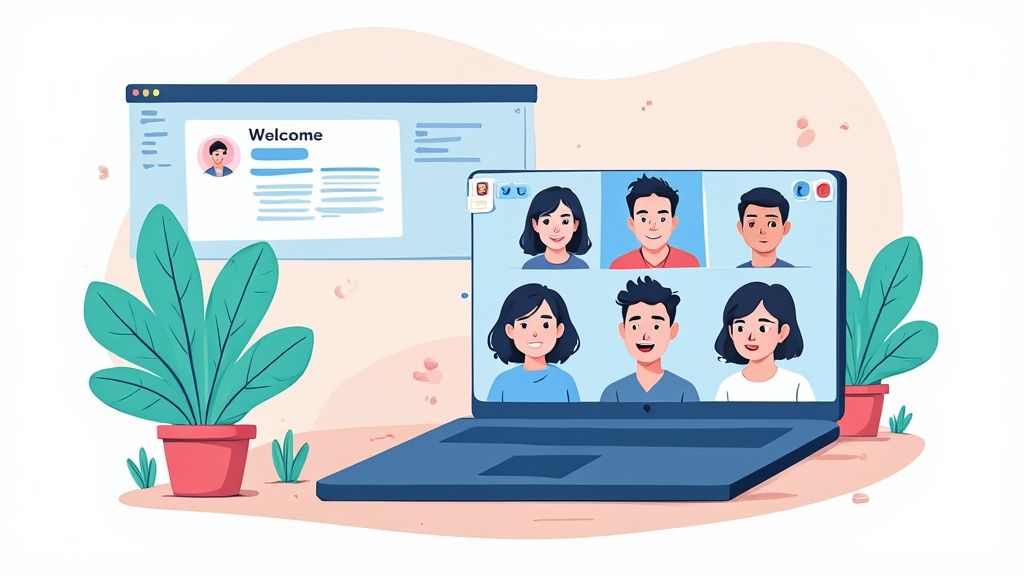
The remote onboarding clock doesn't start on an employee's first day. It starts the second they accept your offer. This crucial pre-boarding phase is your first real chance to make a lasting impression, turning what used to be administrative busywork into a warm, engaging welcome that sets the tone for their entire career with you.
The time between a candidate saying "yes" and their official start date is often dead air, filled with a bit of uncertainty for the new hire. A smart pre-boarding plan bridges that gap, making new team members feel valued and connected before they even log in for their first meeting. A generic welcome email just doesn't cut it anymore if you want to build real momentum and excitement.
This initial period is about more than just logistics—it’s your company culture in action. The whole point is to make every new hire feel seen, prepared, and genuinely fired up to contribute from day one. When you nail this, you all but eliminate those first-day jitters and seriously speed up their ramp-to-productivity.
A well-planned pre-boarding experience transforms administrative chores into meaningful touchpoints. Think of it as a carefully orchestrated series of interactions designed to build comfort and familiarity. The secret is to be proactive and intentional, not reactive.
This timeline gives you a simple but powerful pre-boarding schedule, showing how you can space out key actions to build momentum without overwhelming your new hire.

By front-loading equipment delivery and IT setup, you make sure their first day is all about connection and learning—not troubleshooting tech issues.
Let's break down these critical pre-boarding actions into a clear checklist.
This timeline maps out the essential actions to take between the moment a candidate accepts your offer and their first day on the job, ensuring a smooth and welcoming start.
| Timeline | Action Item | Objective |
|---|---|---|
| 3 Weeks Out | Official Offer & Paperwork: Send the offer letter and all necessary HR documents digitally. | Formalize the employment and complete administrative requirements efficiently. |
| 2 Weeks Out | Logistics & IT Setup: Ship the company laptop, monitor, and any other required hardware. Create all necessary system accounts (email, Slack, etc.). | Ensure all technical tools are in hand and ready to go before day one to avoid delays. |
| 1 Week Out | Welcome & Introductions: The hiring manager sends a personal welcome email. Schedule a brief 15-minute intro call with their assigned onboarding buddy. | Build personal connections and provide a friendly point of contact for informal questions. |
| 3 Days Out | First Week Itinerary: Send a detailed schedule for their first week, including links to meetings and names of people they'll meet. | Reduce first-day anxiety by setting clear expectations and showing you're organized. |
| 1 Day Out | Final Check-in & Swag: Confirm they received their equipment and all is working. Send a welcome kit with company swag. | Create excitement and reinforce a positive company culture right before they start. |
Following a structured plan like this proves you’re an organized, people-first company before they’ve even worked a single hour. It’s your first, and best, defense against new-hire anxiety and disengagement.
While getting the logistics right is important, it's the human connection that truly makes a pre-boarding experience stick. Nobody wants to feel like just another number on a checklist. Small, personal gestures can have a massive impact on how a new hire sees your company.
The pre-boarding phase is also the perfect time to handle necessary paperwork smoothly and provide early access to key systems. This proactive approach dramatically reduces the cognitive overload on day one, letting the new hire focus on absorbing information about their role and the company, not on filling out forms.
Unfortunately, this is where many companies drop the ball. A recent study found that a staggering 63% of remote employees felt their onboarding was inadequate, leaving them feeling disoriented. It often stems from a lack of preparation before the first day even begins. Worse, 37.4% of HR professionals admit the remote onboarding process is their top challenge when trying to fill remote roles, highlighting a huge gap between what's intended and what's actually delivered. You can dig into more data on remote onboarding challenges to see the full picture.
By giving new hires early access to essential tools—like your communication platform (Slack, for example), project management software, and HR system—you empower them to get familiar on their own time. This one simple step can be a game-changer for their confidence, making the official onboarding feel less like a whirlwind of new information.

A new hire’s first week sets the tone for their entire experience with your company. In an office, there’s a natural buzz of activity, but a remote start can feel isolating and disorganized without a deliberate plan. The goal is to design a first week that thoughtfully balances connection, learning, and early productivity, turning potential overwhelm into genuine confidence.
This isn't about plowing through an HR checklist. A high-impact first week is a carefully curated experience. It should blend necessary admin tasks with engaging, interactive sessions that make your company’s mission and culture feel real. Get it right, and your new hire ends the week feeling connected, empowered, and ready to make a difference.
The first day should be all about a warm welcome and orientation, not drowning the new hire in paperwork. While some admin is unavoidable, try to knock most of it out during the pre-boarding phase. This frees up Day One for the high-value interactions that create a real sense of belonging.
A great first-day schedule might look something like this:
It's also a good idea to sprinkle in self-paced activities, like exploring the company's internal knowledge base or watching a pre-recorded welcome from the CEO. This mix of live interaction and independent learning prevents Zoom fatigue and gives them room to absorb everything.
The move to remote work has put a spotlight on the human side of onboarding. It's a huge challenge—nearly half of managers (49.7%) find it one of their toughest jobs. This is made worse by the fact that 41% of remote workers already feel disconnected from their colleagues. These figures, highlighted in a study about remote onboarding challenges, show just how critical it is to build relationships right from the start.
To fight this, you have to be intentional about creating opportunities for connection throughout the first week.
A new hire's first week should be less about what they need to do and more about who they need to know. Focus on building relationships first; the tasks will follow.
Schedule a series of strategic 1-on-1 meetings that go beyond simple hellos. These conversations are the bedrock for the relationships a remote employee needs to truly thrive.
Example 1-on-1 Meeting Schedule
These meetings create a vital web of support, making the new hire feel like a true part of the team, not just an icon on a screen.
The first week is a delicate dance. You want your new hire to feel productive, but not crushed by the pressure to perform immediately. A fantastic strategy is to assign a small, low-risk "first-week win" project.
This could be something as straightforward as:
Finishing a real task, no matter how small, delivers a powerful sense of accomplishment. It shifts their mindset from passive learning to active contribution, building momentum that will carry them into the weeks ahead. That early win is proof that they were hired to make an impact—and they're already on their way.

In an office, culture feels like it just happens. It’s built in the spontaneous chats by the coffee maker, the shared lunches, and the subtle cues you pick up in meetings. But when your team is distributed, those organic touchpoints disappear.
A strong, positive remote culture doesn't just spring up on its own. It has to be built with intention, starting from day one of a new hire's journey. Without this, new team members can quickly feel like isolated freelancers instead of valued colleagues. Your onboarding has to deliberately forge these bonds to make sure every person feels seen, supported, and truly part of the team.
One of the best ways to kickstart these connections is through an onboarding buddy program. This isn't just pairing someone up with a random colleague. It's about creating a structured, supportive partnership that helps a new hire find their footing during those first crucial months. Think of the buddy as a friendly guide to all the unwritten rules of the company.
For the program to really work, everyone needs to know their part.
The Buddy's Role: Their main job is to be a safe, informal resource. They answer the questions a new hire might be hesitant to ask their manager, like, "What's the real expectation for Slack response times?" or "Who's the best person to talk to about expense reports?"
The Manager's Role: The manager should introduce the buddy and clarify their role. It’s crucial to frame it as a peer relationship for cultural guidance, not performance tracking.
The New Hire's Role: Encourage the new person to take the lead. Give them a list of potential conversation starters, from understanding team communication habits to learning the best internal channels for different types of questions.
To get the ball rolling, schedule the first few check-ins automatically. A 30-minute virtual coffee during week one, followed by weekly 15-minute catch-ups for the first month, establishes a reliable rhythm. This structure is what keeps the relationship from fizzling out after the initial introduction.
Let's be honest, the term "virtual team-building" can sometimes make people cringe, bringing to mind awkward video happy hours. The key is to create low-pressure activities that feel natural and help colleagues connect on a personal level.
Try mixing synchronous and asynchronous activities:
Remember, building connections is an ongoing effort. Implementing broader strategies to improve employee engagement is vital for retaining your talent long-term.
Every company has them—the "way things are really done around here." In an office, you absorb these by watching others. In a remote setup, you have to make the implicit, explicit.
The biggest barrier for a remote new hire isn't mastering their tasks; it's decoding the invisible cultural fabric of the company. Your job during onboarding is to make that fabric visible.
Leadership storytelling is a powerful tool here. During an all-hands meeting, have a leader share a story about a past failure and what the team learned. This demonstrates vulnerability and sends a clear message about the company's values around risk-taking.
Dedicated Q&A sessions with a panel of veteran employees are also incredibly useful. Frame it as an "Ask Us Anything" session to create a safe space for newbies to ask about anything from communication etiquette to career paths. Learning how to steer these conversations is a key leadership skill, and you can find great tips on how to manage remote teams to ensure they are productive.
When you make these "rules" transparent, you turn newcomers from outsiders into true insiders.
Let’s be honest: effective remote onboarding doesn’t end after a week of welcome meetings and initial training. To really embed a new hire into your company and set them up for the long haul, you need a clear roadmap that guides them through their first three months. The 30-60-90 day plan is a game-changer here, turning the vague goal of "getting up to speed" into a series of tangible, achievable milestones.
For a remote employee, this kind of structure is non-negotiable. It provides the clarity and direction they need to build confidence and momentum when they can't just pick up cues from walking around an office. Think of it less as a rigid performance contract and more as a collaborative guide that shows them exactly what success looks like at each stage.
The first month is purely about immersion. The primary objective is for the new hire to learn, not necessarily to ship major results. Their focus should be on grasping the core mechanics of their role, the team, and the company as a whole.
This phase is all about building a solid foundation. Key activities should include:
A realistic goal here for a new software developer might be successfully shipping their first small, non-critical bug fix. For a marketer, it could be shadowing customer calls and documenting key takeaways about your audience. The point is active learning through doing.
Once that initial learning phase is complete, the focus gently pivots toward active contribution. During days 31-60, your new employee should start applying what they’ve learned by taking ownership of smaller, well-defined tasks. They’re moving from observing to participating.
This is the period where they truly begin to carve out their place on the team.
In the second month, a new hire should feel less like a student and more like an apprentice. They're still learning, but now they're learning by contributing directly to the team's goals.
For instance, that software developer might now tackle a small feature implementation with guidance from a mentor. The marketer could be asked to draft their first blog post or create a social media content calendar for an upcoming week. These tasks have a clear scope and a tangible output, which is crucial for building a sense of accomplishment.
The last phase, from day 61 to 90, is all about fostering independence and proactive initiative. By now, the employee should have a firm grasp of their role and the team’s processes. The goal is to see them operate more autonomously, identifying needs and driving their own work without constant hand-holding.
This doesn't mean they're left completely on their own, but the manager's role evolves from direct instruction to high-level guidance and support. Success in this phase looks like the new hire starting to solve problems independently and even suggesting improvements.
Unfortunately, far too many organizations drop the ball here. The investment in onboarding varies wildly; while some companies dedicate months to a comprehensive process, many allocate less than a single day. This is a massive misstep. A staggering 11% of companies invest several months to fully onboard new employees, according to Deel. That extended support is vital because a new hire's first few months are when they truly decide if the role is a good fit, which directly impacts retention and your bottom line. You can learn more about how onboarding duration affects business performance on Deel.com.
A strong 90-day mark might see the developer proposing a small refactor to a piece of code they've been working on, or the marketer analyzing campaign data to suggest a new A/B test. They aren't just completing assigned tasks anymore; they're starting to think strategically and contribute to the team's future. This three-month journey provides the runway they need to truly take flight.
To make this structure concrete, it helps to put it down on paper. A simple framework can align both the new hire and their manager on what to expect and when.
| Phase | Focus Area | Example Goal |
|---|---|---|
| Days 1-30 | Learning & Immersion | Learn the company's tech stack, meet all team members, and successfully complete a small, low-risk task. |
| Days 31-60 | Contribution & Integration | Contribute to a team project, take ownership of a recurring task, and present findings in a team meeting. |
| Days 61-90 | Autonomy & Initiative | Lead a small project or initiative, identify a process improvement, and begin mentoring newer team members. |
This table isn't meant to be a rigid checklist but rather a starting point for a personalized plan. By collaborating on these goals, you empower your new remote hire with a clear path to becoming a valued, productive, and independent member of your team.

When you're working remotely, your tech stack is the office. It's the hallway, the conference room, and the water cooler all rolled into one. Simply throwing a bunch of apps at new hires is a recipe for confusion, not clarity. The best remote onboarding uses technology to support and simplify the journey, not overcomplicate it.
The real goal isn't to chase the shiniest new software. It’s about being thoughtful, selecting a core set of tools that work together to create a single source of truth for your new employee. Get this right, and your tech stack will empower them, foster their independence, and make them feel connected from day one.
One of the most common mistakes I see is treating each tool like a separate island. Your project management app, your communication platform, and your knowledge base need to talk to each other. This integration is what separates a smooth, professional process from a chaotic, disjointed one.
A great place to start is with a project management tool like Asana or Trello. Use it to build a transparent onboarding checklist. This gives new hires a clear roadmap for their first few weeks, showing them exactly what’s been done and what’s coming up next. It completely removes the guesswork and the anxiety of the unknown.
For example, we create a template board for all new hires with columns for "To Do," "In Progress," and "Done." Seeing those cards move across the board is incredibly satisfying and gives new hires a real sense of accomplishment.
Your communication platform, whether it’s Slack or Microsoft Teams, is where your company culture lives and breathes. It’s where relationships are built and quick questions get answered. For a new hire, this tool is their lifeline.
Here’s how to make it a genuinely welcoming space:
The right mix of digital tools is essential. If you’re still building out your company’s stack, you can find a solid list of remote collaboration tools that can help streamline how your distributed team works together.
Nothing slows down a new hire—or their manager—more than having to ask and answer the same questions over and over again. This is where a centralized knowledge base becomes your most valuable player. It's the single source of truth where you document everything from company policies to team-specific workflows.
A new remote hire’s confidence is directly tied to their ability to find information independently. A robust knowledge base is the single most important tool for fostering autonomy.
This hub, built in a tool like Confluence, Notion, or even a meticulously organized Google Drive, becomes the go-to resource for everything. It slashes repetitive questions, empowers employees to help themselves, and ensures everyone is operating from the same playbook.
Finally, don't forget that the physical workspace is a critical piece of the tech puzzle. A new hire can have the best laptop in the world, but if their home setup is uncomfortable, their productivity will tank. To help them get started, you can share helpful resources with top office desk setup ideas to boost productivity. It's a small gesture that shows you genuinely care about their well-being and success.
Even the most meticulously planned remote onboarding process will throw you a curveball. It’s inevitable. You’ll have a solid blueprint, but then a unique situation pops up, demanding a quick, clear answer. This is where we tackle some of the most common—and frankly, tricky—questions that managers and HR teams run into.
From the logistical headache of different time zones to the challenge of actually knowing if your program is working, let's dive into the nitty-gritty of making remote onboarding a success.
This is a massive hurdle for any global team, and one I see companies stumble over all the time. The secret is to fundamentally shift your thinking from synchronous-first to asynchronous-first. Sure, some live interaction is crucial, but you can’t realistically expect a new hire in Manila to be bright-eyed for a 9 AM EST standup every single day.
Instead, your priority should be building out a rich library of resources they can tap into on their own time.
This approach shows you respect your new hire’s time and personal life, while still giving them the same foundational knowledge as everyone else.
"Success" in remote onboarding isn't just about checking boxes off a list. To get the full picture, you need a smart mix of qualitative and quantitative data. A manager's gut feeling is a good start, but it won’t give you the actionable insights you need to improve.
You can’t improve what you don’t measure. Tracking a few key metrics turns onboarding from a 'people function' into a data-informed strategic advantage.
Here are a few metrics I always recommend tracking:
Gathering this kind of data gives you concrete insights. It helps you find the weak spots in your process and make targeted improvements for your next group of new hires.
A one-size-fits-all approach to remote onboarding is a classic recipe for failure. The first week for a new software engineer should look completely different from the first week for a new salesperson. The core cultural onboarding can stay consistent, but the role-specific training absolutely must be tailored.
For example, an engineer’s first week should be laser-focused on getting their local development environment set up and maybe even tackling their first small bug fix. A new salesperson, on the other hand, should be shadowing customer calls and learning the CRM inside and out. For a deeper dive, our complete guide on onboarding remote workers breaks down tailored strategies for various positions.
The key is to work directly with the hiring manager to map out a specific 30-60-90 day plan for each and every role. This is non-negotiable. It guarantees every new team member gets the focused, relevant information they need to start contributing and feeling successful right away.
